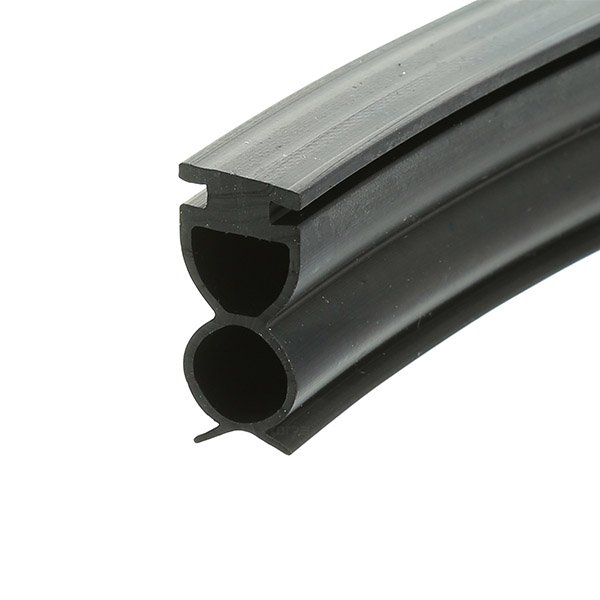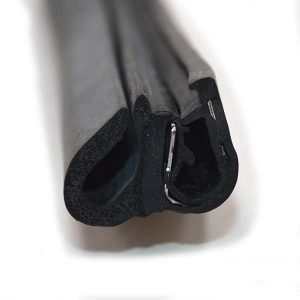“EPDM vs neoprene: What are the differences?” is a trendy topic that most rubber seal buyers frequently ask. EPDM and Neoprene rubbers are both very popular in most industries worldwide. In this case, they have differences based on various factors that make them suitable for specific applications. Therefore, it is necessary to understand the fundamental differences between EPDM and Neoprene to make the choices easier for rubber seal buyers.
“EPDM vs neoprene: Which material should you choose? ” highlights the fundamentals of these two materials (EPDM vs neoprene). Later, it will also discuss those factors that divide these materials’ application. So, take time and read the following sections, and we hope you will understand EPDM vs Neoprene better than before.
Introduction to EPDM vs Neoprene Rubber
EPDM and neoprene are prevalent rubber materials that you may find nearby. These two materials feature excellent sealing properties and good resistance to heat, weather, ozone, contaminants, etc. Before we jump into the details of the differences, let’s first glance at the fundamentals.
What is Neoprene Rubber?
Neoprene is a synthetic rubber developed in 1930. It comes from the polymerization of chloroprene. Hence, neoprene has another name, polychloroprene. This material is highly elastic and can withstand a load of up to 3000 PSI. Excellent chemical stability and flexibility are provided by neoprene in a variety of applications.

Application
Neoprene is prevalent in many industries, including medical, buildings, construction, automotive, electrical appliances, etc. PPE or personal protective equipment, automotive transmission belts, vehicle vibration mounts, power transfer belts, installation sealing strips, noise reduction seals, etc., are the best examples of neoprene applications.
Pros:
Excellent for roofing systems.
- Neoprene is non-toxic and fire-retardant.
- Neoprene can gain its original shape from up to 1000% of the elongation.
- It is an eco-friendly material.
- It is famous for its excellent load absorption and cushioning capabilities.
- The best benefit of neoprene is its resistance to oils and chemicals. Neoprene survives easily with oils, acids, alkalis, and others.
- Neoprene is also resistant to weather and ozone.
Cons:
- Compared to EPDM, neoprene has fewer capabilities over heat resisting. It can withstand up to 225 degrees Fahrenheit. On the other hand, EPDM can resist up to 350 degrees Fahrenheit.
- Neoprene is not compatible with ketone hydrocarbons.
- Neoprene is more expensive than EPDM.
What is EPDM Rubber?
EPDM is also known as Ethylene Propylene Diene Monomer. It is also a synthetic rubber that is highly flexible, durable, and resistant to weather, heat, ozone, etc. The origin of EPDM rubber was from an experiment in 1960 that was aimed at creating a flexible and robust material that could resist various environmental factors. The composition contains:
- A small non-conjugated diene monomer.
- 3% to 9% of the overall chemical composition.
- We are providing a cross-linking site for vulcanization.
Besides, the ethylene content in the chemical composition is between 45% and 75%, containing more filler-loading possibilities.

Application
EPDM is popular in automotive parts, construction, and HVAC applications. EPDM seal strips for cabinet doors and windows, EPDM seals for car windows, and EPDM seals for marine applications are famous examples of EPDM rubbers. If you are interested in learning more about the application of EPDM, read our article “EPDM: Everything you should know.”
Pros:
- EPDM can recover its original size from up to 600% of elongation.
- It is ideal for high-temperature applications.
- It can resist any weather, sunlight, contaminants, ozone, etc.
- EPDM is also famous for its excellent noise-reduction capabilities.
- It is an incredible electric insulator.
- Cheaper than neoprene.
Cons:
- EPDM swells in contact with oils or acids.
The Difference Between EPDM and Neoprene
Before making a detailed comparison, let’s check out the following table. We hope this table will help you quickly understand the fundamental differences between the materials (EPDM vs Neoprene).
| Contents | EPDM Rubber | Neoprene Rubber |
| Appearance | Both EPDM and Neoprene have similar outfits. | |
| Resistance Property | EPDM is the best option for weather protection. | Neoprene is the best option for chemical safety. It is excellent not only for chemicals but also for other hydrocarbons. |
| Temperature Limits | Can withstand temperatures as low as -50ᵒC and as high as 150ᵒC. | Neoprene has a lower temperature than EPDM, which is between -50ᵒC to 120ᵒC. |
| Durability | EPDM and Neoprene rubbers are incredibly durable, making them the most attractive material. | |
| Fire Protection Property | According to the standard FMVSS302, both rubbers (EPDM vs Neoprene) are flame retardant. | |
| Noise and Vibration Resistance | EPDM and neoprene offer good noise absorption, reducing the intensity of noise and vibrations for the user. | |
| Cost | Comparatively cost-effective option. | Comparatively more expensive than EPDM. |
| Strength | Both rubbers are robust elastomers with good tear and abrasion resistance properties. | |
| Compression Capability | Both rubbers (EPDM vs Neoprene) can withstand considerable pressure. This property lets them keep their original shape even after compression and elongation. |
According to the above table, we have seen that both EPDM and Neoprene rubber share similar properties, but some unique properties accelerate the product’s viability. Those special properties make them appropriate for different applications. However, we have stated four significant factors that differentiate between EPDM and Neoprene in the following.
Physical Properties
EPDM rubber came from an experiment. The aim was to create a flexible and robust material that could resist various environmental factors. EPDM stands for ethylene propylene diene monomer. On the other hand, neoprene came from chlorine polymerization or chloroprene.
EPDM is suitable for outdoor applications, such as weatherstripping for doors and windows. This material resists weather, excessive heat, noise, or contaminants. Besides, EPDM also has excellent resistance to ozone and sunlight. As mentioned, EPDM hardly survives in oils and solvents. On the other hand, neoprene is a perfect choice for resisting oils and solvents. Besides, neoprene is also the best option for fighting acids and chemicals.
However, both materials can withstand high loads ranging from 500 to 3000 PSI or 4Mpa to 30 Mpa, resulting in high tensile stress. Both rubbers (EPDM vs Neoprene) are robust elastomers with good tear and abrasion resistance properties. Above all, it is essential to note that EPDM and neoprene look alike in their outfits. Due to this, people often need help choosing the perfect material for their projects.
Temperature Limits
Both EPDM and neoprene rubber compounds are incredibly resistant to heat and cold. However, EPDM offers better performance than neoprene in this case. Typically, EPDM can withstand freezing temperatures as low as -50ᵒC and hot temperatures as high as 150ᵒC. On the other hand, neoprene can withstand a lower temperature band than EPDM, ranging from -60ᵒC to 120ᵒC.
Both EPDM and neoprene are perfect fire retardants and provide excellent fire-extinguishing properties. According to the standard FMVSS302 (Federal Motor Vehicle Safety Standard No. 302), EPDM and neoprene seal strips are ideal for all automotive vehicle parts because of their burn resistance capabilities.
Durability and Stability
The most critical factor every buyer checks when selecting a perfect rubber for the target application is the durability and toughness of the product. In this case, EPDM and neoprene are ideal for any application where the rubber is necessary. However, EPDM is the most durable material made of artificial technology.
On the other hand, neoprene is also famous for its durability. Neoprene’s elastic and abrasion-resistant properties make it stable and durable. Above all, neoprene is also a good choice for weather protection.
Price
Typically, neoprenes are more expensive than EPDM rubber. EPDM is a versatile rubber that is a popular and cost-effective solution for all systems. You should consider the performance of the material rather than the price. However, there are some cases where both EPDM and neoprene work perfectly. In those cases, you can go for the cost-effective solution.
Is EPDM Better Than Neoprene?
It is one of the most common questions we frequently ask. However, the answer to this question is always the same for us. All materials (EPDM vs neoprene) are better if you determine the specific applications. The necessity of these two rubber materials depends on the use or application of the material.
Neoprene has some better attributes than EPDM rubber and is ideal for resisting oils, chemicals, acids, or other hydrocarbons. On the other hand, EPDM is the best option for fighting UV lights, extreme weather, outdoor noise, and ozone. Therefore, you should first know the application, and then you can decide which material would be the best option for your project.
We have mentioned above that both rubbers (EPDM vs Neoprene) have a similar outfit. These materials provide excellent age resistance and seal against moisture, liquids, outdoor contaminants, insects, etc. According to the standard FMVSS302, both rubbers (EPDM vs Neoprene) are flame retardant.
Final Thought
While EPDM (ethylene propylene diene monomer) is a synthetic rubber possessing excellent durability, neoprene is a product from the polymerization of chlorine. Both materials are superior and resistant to moisture, liquids, and contaminants. In this case, EPDM is the best option for weather resistance, and on the other hand, neoprene would be the best choice for chemical resistance.
From the above discussion, we have got the fundamental properties of these two materials (EPDM vs Neoprene) and highlighted the differences also. We hope this information will help you choose the best material for your application. However, don’t hesitate to contact us if you require more details regarding Neoprene vs EPDM rubber seal strips. We are one of the leading rubber manufacturers in the world. We have all the popular materials for rubber products. Besides, we keep the best customer service team to make communication between the customers and experts easier.
